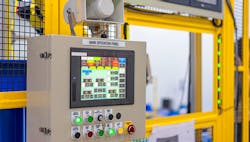On-machine components are nothing new, and their increased use is driven by many of the same trends driving many aspects of automation and product development—smaller components, more open platforms and advanced data analysis.
Perry Hudson, key account manager—packaging, Pepperl+Fuchs, says on-machine component structure can be broken down into seven key categories:
- power distribution
- motor control and drives
- safety systems
- programmable controllers
- discrete and analog I/O
- communication systems
- human-machine interfaces (HMIs).
Innovation is happening in all these categories, Hudson says. For example, to monitor power distribution, advanced measurement devices on machinery provide information to help machines run more efficiently.
Motors and drives represent one of the most used components for on-machine setups, Hudson says. “This includes smart motor control that can provide real-time data for predictive maintenance using IO-Link and new electric drive units (EDUs) that combine the power electronics gearbox and motor in one package for increased efficiency,” he says.
Safety is one area realizing significant advancements with on-machine components. “Technologies include smart monitoring in real time using IO-Link, machine safeguarding with technologies, such as ultrasonic and 3D LiDAR sensors, as well as artificial intelligence (AI), all combined in common software language,” Hudson says.
As PLCs become more powerful, Hudson says, some are being used as Web hosting devices. “More and more people are turning to thin clients and industrial-box PCs to manage their machines,” he adds.
Industry 4.0 has saturated almost all aspects of automation, and the use of on-machine components is no exception. “Sensors are now intelligent and capable of communicating their status, as well as providing key predictive maintenance information. They can also be accessed to change their parameters spontaneously, therefore making recipe updates very simple,” Hudson says. The world of analog is waning, he adds, as discrete communication is faster and more specific.
Open platforms have opened many doors for automation. “It is very easy to work with companies today who offer open-platform communication devices that allow you to handle higher-level machine communication through platforms such as MQTT and OPC UA,” Hudson says. “At the same time, these devices can simultaneously talk EtherNet/IP, Modbus TCP, EtherCAT or Profinet directly to a machine and its components. This allows for machines to communicate with each other, no matter the manufacturer.”
Like industrial communication, HMIs have become more reliable and easier to integrate, Hudson says. HMIs have fewer components now and have enhanced communication abilities, such as talking to EtherNet/IP, Windows or Linux, as well as the ability to handle OPC UA communication on the side, enhancing the capacity for in-the-field repairs.
Ingress protection ratings
“There are no control cabinet features that can’t be placed on-machine now or in the coming year,” says Tom Jensen, head of system sales and technology evangelist at Murrelektronik. “The trick for IP67 has always been protecting the three-phase +400-Vsupplies needed to power larger motors on a machine. Up to now, this has been difficult because there were always a few peripheral components—24 Vdc power supplies, noise suppressors or breakers—rated IP20 that would need to be in a cabinet. With better material sciences, for better housing and heat transfer, and electronics with noise and circuit protection built in, those IP20 peripherals are being moved into the IP67 power components. There aren’t too many things left in the cabinet.”
Smart components
On-machine components have had a great impact on machine builder’s expectations of manufacturers, says Jeremy Valentine, director of industrial electronics at Phoenix Contact USA. “We’re shifting into an era where component connectivity and/or smart features are becoming the norm. Manufacturers content with simply providing components without easy-to-access support documentation and without easy integration into cloud-based system architectures will soon find themselves on the outside looking in,” Valentine says.
Components also continue to get smaller and smaller, with tool-free connection technology. “The obvious benefits of this trend are components taking up less space, while being faster and easier to install,” Valentine says. Both are a huge benefit to machine builders, many of whom are facing order backlogs, he adds.
With smarter components, builders can do more with less. For example, uninterruptible power supplies can communicate information like how much battery charge is left or if the battery is nearing its end of life. “What’s more, a lot of this information is extending beyond local systems and now finding its way into cloud-based systems for analysis and often action. These actions often alleviate or significantly reduce unplanned downtime,” Valentine says.
Predictive maintenance
The market is trending toward the implementation of remote and autonomous operations and monitoring through the Industrial Internet of things (IIoT) connectivity, says Brian Jaegar, engineer at Maple Systems. Sensors can monitor many factors that affect productivity, such as temperature, vibration, rotational direction, operational status, usage times, tool wear and downtime, he adds.
“On-machine components can create a more integrated and cost-effective solution versus a traditional setup that may be overdesign or overkill in capabilities and budget for a system that doesn’t need a full redesign,” Jaeger says.
Advances in connector technology, which have integrated sensor and diagnostic functions into the connector, open completely new fields of applications and make additional sensor technology superfluous, says Andrew Barco, director of automation products and solutions at Weidmüller. Diagnostics built into the sensors themselves cut down on the number of sensors used on the machine to reduce design time. “Not only are we seeing traditional devices like sensors utilizing M12 connections, but also power supplies and Ethernet devices that are rated for on-machine use,” Barco says. “By using smart components, the goal is that the machine will tell the user when it needs to be serviced in optimal production range,” Barco says.
It’s also not always possible to eliminate a control panel, Barco says. “The balance between components that are suited for on-machine vs. in the control panel is usually done during the design phase with some key points considered: the amount of human interaction required on a regular basis; the suitability of battery power based on current consumption; and ease of maintenance,” he says.
Data collection and storage
Development continues for IP65- and IP67-rated remote I/O modules, says Eric Rice, product market manager for electric automation at Festo. “These dust- and moisture-tight modules provide local connection points for digital and analog I/O, as well as higher-end functionality such as IO-Link masters,” Rice says. Flexibility is crucial, he adds. Configurable I/O points allow users to define the mix of inputs and outputs needed per module.
“IO-Link masters enable the use of smart sensors and actuators at more places around the machine, with an increasing number of actuators taking the form of smart motion axes with actuator, motor and servo drive integrated into a single product,” Rice says.
The availability of on-machine components, such as smart sensors, integrated motors, valve manifolds, I/O blocks or vision sensors is not new,” says Tom Worsnopp, product market manager of electric automation at Festo. “What is new is the widespread acceptance and proliferation of on-machine components to create smarter machines, gather more data and improve their processes,” Worsnopp says.
Festo solved a challenging application by moving a proportional-integral-derivative (PID) control loop from the in-cabinet master controller to a dedicated on-machine controller located closer to the process. “Initially, the PID loop for a pneumatic actuator was being run by the main controller located in the control cabinet,” Rice says. “Latencies in signal processing between digital signals from the master controller and analog signals to the valves and flow sensors caused the PID loop to run slowly.” Moving the PID loop to a dedicated on-machine pneumatic controller at the location of the process decreased signal processing times and shortened cycle times.
Cabinet-free
Companies like Bosch Rexroth have packaged cabinet-free technology, where the servo drive is mounted on the servo motor with an IP65 rating and a single hybrid cable to connect one motor to the next. Joaquin Ocampo, product manager at Bosch Rexroth, says the cabinet-free technology has been successful for packaging machines, such as case packers or secondary packaging. New applications with slip rings for cappers machines give them more flexibility. “The machine adjusts to different sizes of products automatically. This is due to the on-machine integrated servo drive,” Ocampo says. Other applications with the cabinet-free technology include carbon-fiber-laying machines and metal forming and metal drilling.
About the Author
Anna Townshend
Managing Editor
Anna Townshend has been a writer and journalist for 20 years. Previously, she was the editor of Marina Dock Age and International Dredging Review, until she joined Endeavor Business Media in June 2020. She is the managing editor of Control Design and Plant Services.

Leaders relevant to this article:


